A tormented man, subversive in appearance, ready to draw the sword from his hip to unleash the fight, the beard, the slightly worn velvets, the disheveled hair with a slightly anarchic cut, seeks and finds in his face the gaze of Goliath.
He is a painter by trade, his pants tight like a pair of jeans, his shoes dirty with mud, a shirt sprinkled with every varnish, often with blood, color encrusted on the hands, under the nails.
And he himself, Caravaggio the “scornacchiato”, resembles a canvas, like the characters that his gaze captures from the Roman Suburra – and from the Church of Santa Maria in Vallicella, where Filippo Neri takes away the hunger from the many derelicts – to transfer to the paintings that putrid reality made up of thieves and prostitutes ready to lend their faces to the most famous madonnas and saints in the history of art.
A quarrelsome frequenter of taverns and street women, Michele Placido’s Caravaggio is the most authentic expression of that “truth” that has always haunted the artist who places the many Christs on the cross on the canvas, finding in reality those Gospels he knows by heart and at whose reading he is moved.
From 3 November The Shadow of Caravaggioan Italian-French co-production signed by Goldenart Production with Rai Cinema and for France Charlot, Le Pacte and Mact Production brings to the cinema the complex existence of Michelangelo Merisi (played by Riccardo Scamarcio) with Michele Placido to sign his fourteenth film as director, Sandro Petraglia, Fidel Signorile and Placido himself on the screenplay, and a cast of big names.

Riccardo Scamarcio (Caravaggio) and Isabelle Huppert (Costanza Colonna) in the film L’Ombra di Caravaggio | Photo: © Luisa Carcavale
Rebellious and restless, devoted and scandalous, independent and transgressive, the Caravaggio 2.0 that Placido brings to the cinema is a pop artist who came to Rome, at that time the center of the world, to draw from that universe of immigrants, priests, prostitutes, pilgrims , cardinals, princes and criminals, and that today he would live his whirlwind existence in any studio in London or New York. Faced with a Counter-Reformation church that asks for statues, domes and paintings to celebrate its opulence in a gigantic construction site of wonders, Caravaggio, like a neo-realist director ante litteram, near the pauperist wing of the church, instead seeks a return to values evangelicals. He finds it in Filippo Neri and in the women of his life, in the Marquise Costanza Colonna (Isabelle Huppert), much more than a friend, who protects him from childhood, in Lena (Micaela Ramazzotti), one of the most famous prostitutes in Rome. , often represented as Mary, the mother of Jesus, and then in Annina, the face of one of his greatest masterpieces, The death of the Virgin, today at the Louvre Museum in Paris, “the most alive death that has ever been painted”.
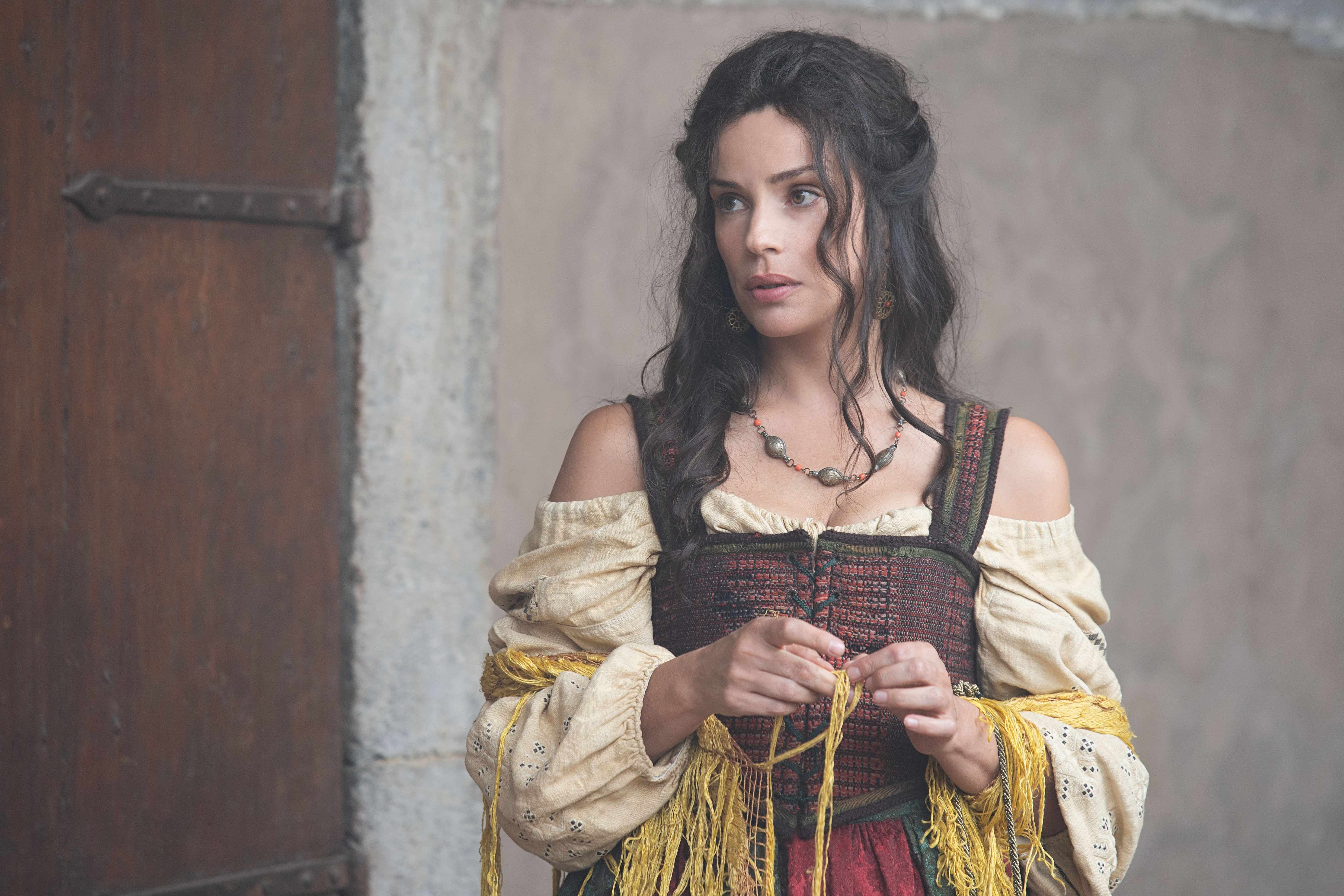
Micaela Ramazzotti (Lena), The Shadow of Caravaggio | Photo: © Luisa Carcavale
The intensity with which the director sets up the scene is striking Death of the Virgin, and not only, with a moving theatricality. A theatricality that the Placido “word maker” and man of the theater could not renounce. We like these echoes of theater that emerge from the staging of the spectacular celebration of Cardinal Dal Monte set up at Villa Aldobrandini, in the Conversion of Saint Paul and of Crucifixion of St. Peterin the very powerful dialogue with Giordano Bruno.
In the sublime confrontation between Caravaggio and the Dominican friar (Gianfranco Gallo), shot in the basement of Naples to represent the prisons in the Rome of the time, there is the whole search for the truth longed for by two men. Like the philosopher of the infinite worlds, Caravaggio too has been playing dice with death since the terrible condemnation weighs on him.
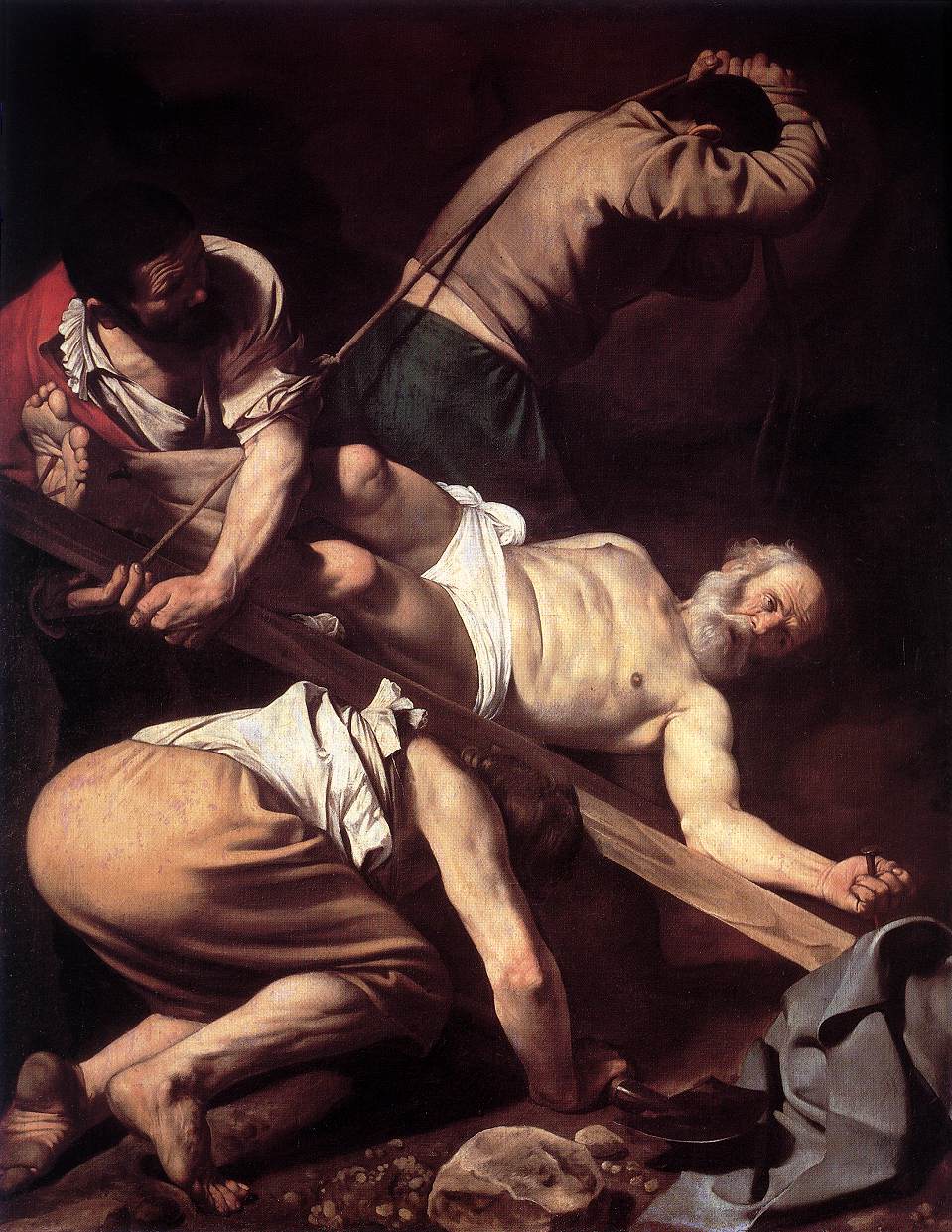
Michelangelo Merisi da Caravaggio, Crucifixion of St. Peter, Cerasi Chapel, Santa Maria del Popolo, Rome
In the film, the protagonists become living works of art. If for Caravaggio reality comes first of all, even the director makes sure that the skin, the feet, the impulses, the vices, the blood, the gazes of his subjects untangle the strings of the spectator before settling on the canvas. The studio where the painter creates his masterpieces, set in the film in Cinecittà, is a bustle of shopkeepers, prostitutes, nobles and prelates, great art collectors such as Cardinal Francesco Del Monte.
So Placido, and this is one of the strengths of the film, rattles off a series of characters, usually little considered, but contemporaries of Caravaggio, emblematic to smell the historical context of the painter and perhaps a little also his art, as well as the ferments of an era, the seventeenth century, where in Rome the Vallicella becomes the variegated forge of its truth.
Caravaggio’s Rome is also the Rome of Orazio and Artemisia Gentileschi and again of Filippo Neri, Scipione Borghese and Cavalier d’Arpino.
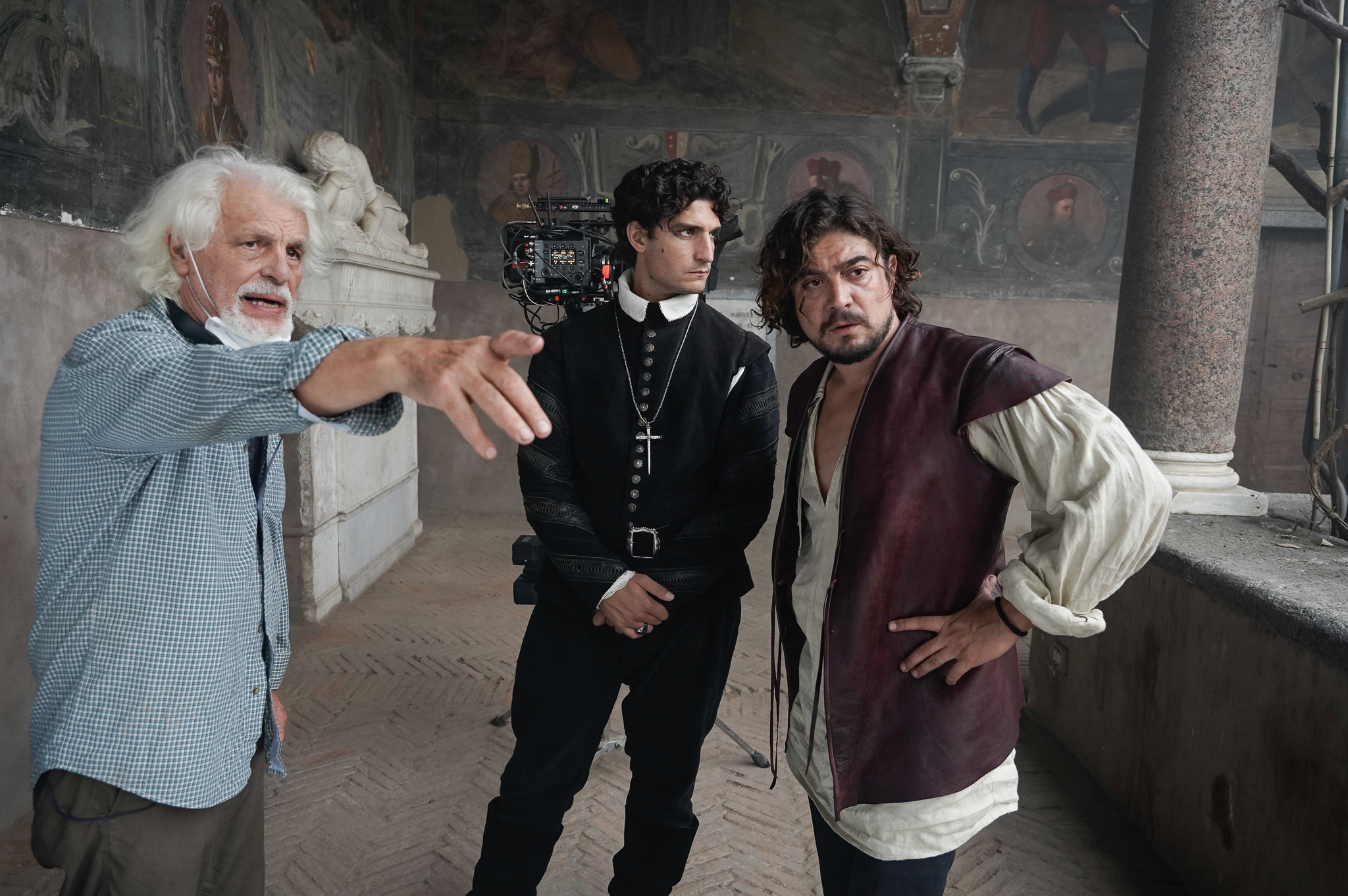
Michele Placido, Riccardo Scamarcio (Caravaggio) and Louis Garrel (the Shadow) in Caravaggio’s L’Ombra | Photo: © Luisa Carcavale
Far from being the protagonist of a lacquered scene, scholastically outlined by a string of works accompanied by captions, Michele Placido’s Caravaggio lives by feeding on reality, by the veracity of the Roman accents that explode from the mouth of Ranuccio (Brenno Placido) and his brother (Michelangelo Placido).
The challenge that consisted in the search for historical adherence and in a period reconstruction that did not aim at rhetorical spectacle but rather at the material substance of the environments was won. As probably also the found of the Shadow (Louis Garrel) a secret agent of the Vatican, at times a bit too static in the film, to which Pope Paul V decides to commission a real investigation that puts Caravaggio and the art of him. It will be she who will decide whether or not to grant the pardon that the painter asked for after the death sentence for killing his rival in a duel. And it will be the Shadow, the only fictional character in the film, to initiate the espionage activities on the painter who, with his life and with his art, fascinates, upsets, subverts.
At the end of the film it will be this same fictional character to decree an ending that could appear anti-historical. But the copyright license can also allow itself to play with the dense mystery that lies around the end of Caravaggio.
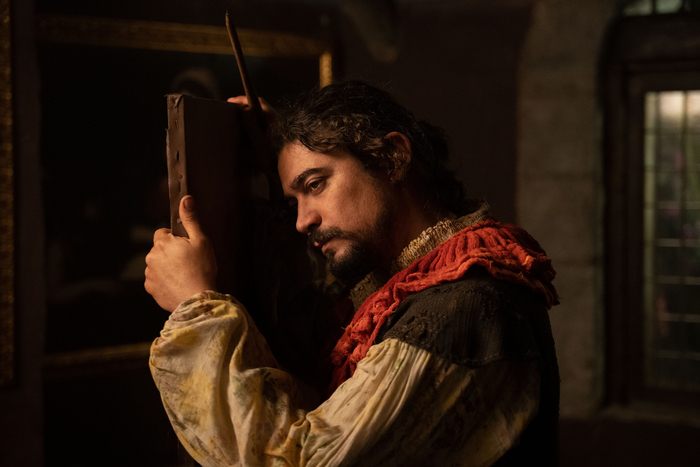
Riccardo Scamarcio in the film L’ombra by Caravaggio I Courtesy 01 Distribution
The work on furnishings and props is very careful in the film, from books to paintings by Caravaggio, which reflects the desire to overcome an iconographic representation already seen. The works were prepared on canvas with material bases that at the time of printing were coated precisely to make the textures of the paintings much more truthful than simple photographic reproductions. Following Caravaggio’s incessant wandering from place to place, the viewer encounters different locations that shatter the stereotypes of the master’s places, in a dirty setting, definitely far from the temptation of an iconographic or glossy representation.
The presence of the places in the film becomes powerful and drags from the sumptuous papal and noble palaces such as Villa Chigi, where part of the Colonna residence was set, to the popular taverns, between churches and fortresses, along the basements of Caracalla transformed into streets towns full of dirt, swarming with sewers and beggars.
We find Naples with its Renaissance and early Neapolitan Baroque churches, where the Contarelli Chapel and the Cerasi Chapel have been rebuilt, but also Sant’Agostino (the Curia of Rome did not allow the filming to be carried out inside the Roman churches) . At Castel Dell’Ovo, on the other hand, the undergrounds of Malta come to life with the Beheading of St. Johnone of Caravaggio’s last works before his return to Naples.
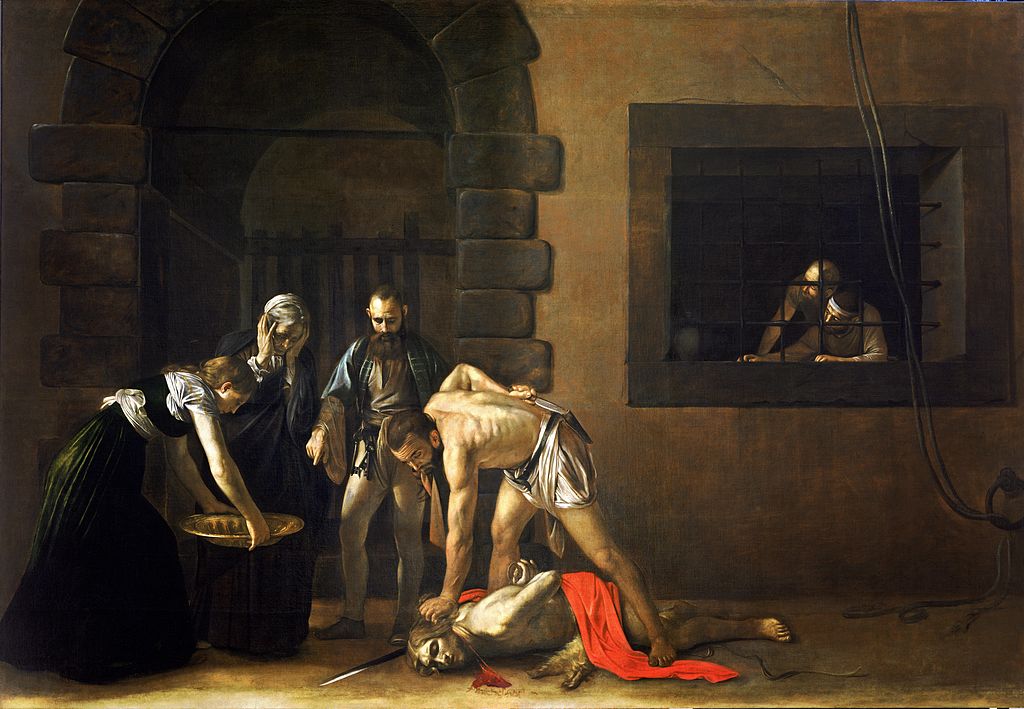
Michelangelo Merisi Da Caravaggio, Beheading of St. John the Baptist, 1608, Oil on canvas, 361×320 cm, St. John’s Co-Cathedral, Valletta, Malta
In this challenge devoid of rhetorical overtones, aimed at restoring the whole earthly, human, painful and carnal dimension of the painter and his time, the costumes for which Carlo Poggioli was inspired by the clothes that Caravaggio loved to wear, sometimes underlining the bond between the clothing and the changes in the life of the painter who, from very simple and poor clothes in the first phase of his life, moves on to a slightly more varied and colorful wardrobe when his fame begins to assert itself.
Excluding temporal jumps that are a bit too fluctuating, reflecting the incessant wandering of the master, but which in some moments make the viewer lose a bit by slowing down the focus on the protagonist a little, Michele D’Attanasio’s photography convinces final surprises. And if love is truly synonymous with truth – a bit like Giordano Bruno’s universe made by an equally infinite God, to be loved infinitely – the final message delivered by Placido through Virgil’s phrase, taken up by Caravaggio, Omnia vincit amoris truly the perfect epilogue of that search for truth that Caravaggio defended with conviction until the end of his days.
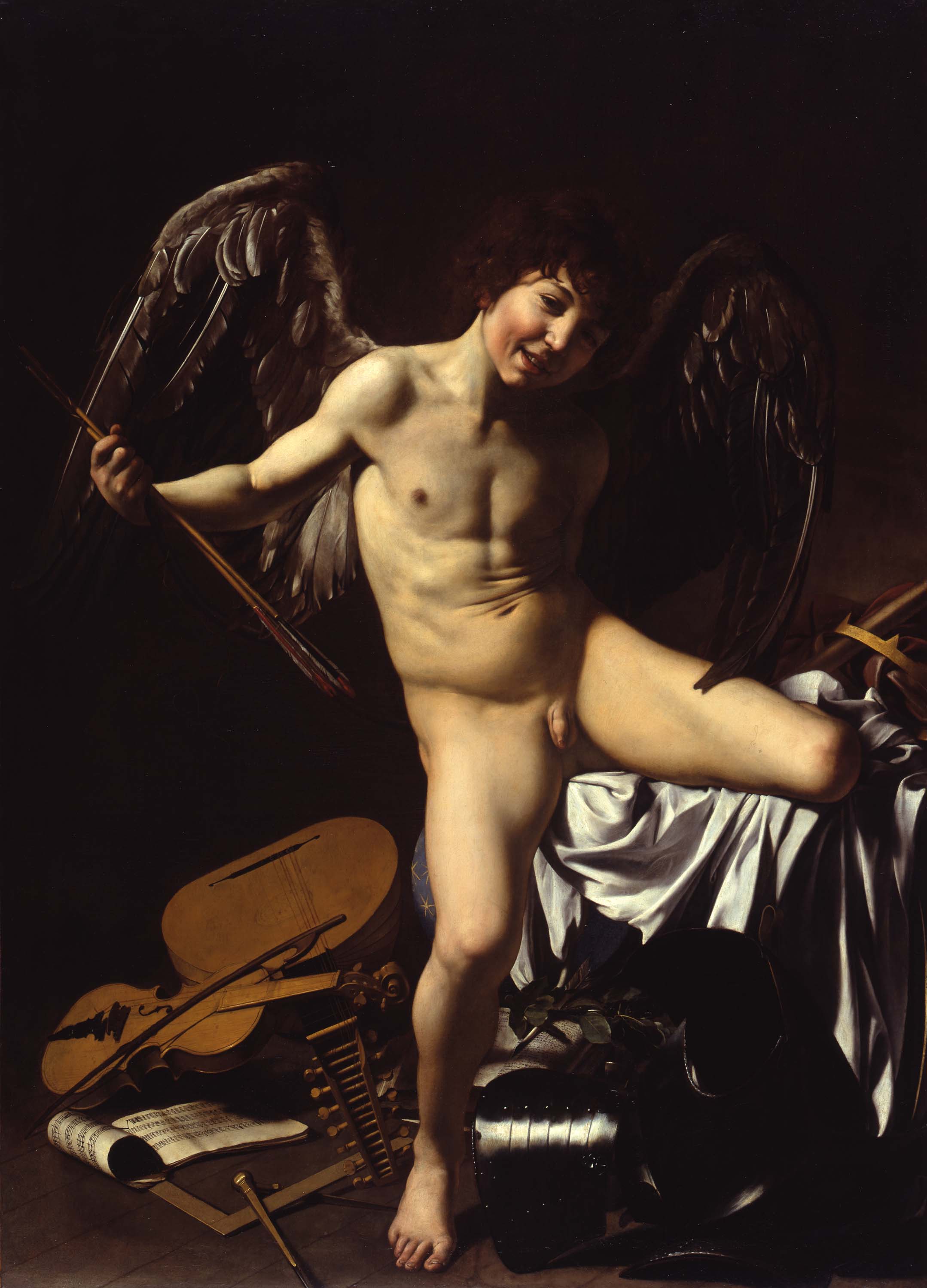
Michelangelo Merisi da Caravaggio, Amor vincit Omnia, Gemäldegalerie, Staatliche Museum, Berlin
![]() Read also:
Read also:
• Michele Placido tells about his Caravaggio, the solitary “director” who sought the truth in painting
• Nine beautiful paintings to be recognized in the film The Shadow of Caravaggio
• The Shadow of Caravaggiofrom 3 November only to the cinema
• Riccardo Scamarcio is Caravaggio in the new film by Michele Placido

